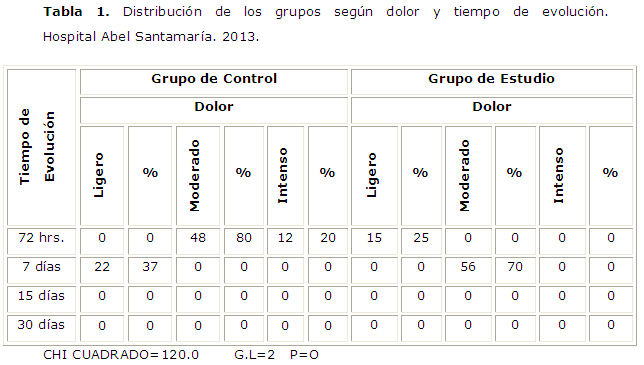Postoperative evolution of surgical wound closure by secondary intention in third molars
Keywords:
Impacted tooth/surgery, Third molar/surgery.Abstract
Introduction: third molar surgery is a treatment often performed during the dentistry practice work. Nowadays it is the most used conventional surgical technique.Objective: to evaluate the postoperative results in patients with non-semi-retained mandibular molars, with closure of the wound by secondary intention, regarding aspects such as the presence of pain, edema, bleeding, sepsis and mandibular trismus.
Methods: an analytical, longitudinal, prospective case-control study was conducted at Abel Santamaria Cuadrado General Teaching Hospital in Pinar del Río, in the period from September 2010 to July 2013. The sample consisted of 120 patients attending the maxillofacial surgery office because of semi-retained mandibular third molars. For statistical analysis we used the Kolmogorov-Smirnov statistic methods and the Fisher exact probability variant.
Results: for the 60 patients operated by conventional surgical suture with vestibular flap, after 72 hours pain appeared, and it was moderate in 48-80%, and at 12 hours, it was intense for the 20%. For the 60 patients operated by surgical technique with wound closure by secondary intention, after 72 hours only 15 patients (25%) had mild pain.
Conclusions: There was a better postoperative result in patients with surgical wound closure by secondary intention, with 45% of the patients with no pain and 90% with slight edema after 72 hours of surgery; the study showed no symptoms such as bleeding, sepsis, or mandibular trismus.
Downloads
References
1. Ali HH. Pattern of third molar impaction in a Saudi population. Clinical, Cosmetic and Investigational Dentistry[internet]. 2010[cited january 2014]: 2 109_113. Availbale from: http://www.dovepress.com/getfile.php?fileID=7892
2. Larrazábal Morón C, Galán Gil S, Peñarrocha Diago M. Revisión bibliográfica de los artículos publicados de cirugía bucal en el año 2005. Rev Esp Cirug Oral y Maxilofac [revista en la Internet]. 2008 Ago [citado 2014 sept 23]; 30(4): 225-245. Disponible en: http://scielo.isciii.es/scielo.php?script=sci_arttext&pid=S1130-05582008000400001&lng=es
3. Lazaridou M, Galitsiou V, Divanidou C, Tilaveridis I. A study of the correlation between second molar distal caries and third molar eruption. Hellenic Archives of Oral & Maxillofacial Surgery[internet].2012[cited january 2014]; 3: 159-166 Available from: http://www.haoms.org/haomsjournal/2012teyxos3_article4.pdf
4. Da Costa MG, Pazzini CA, Garcia Pantuzo MC, Ramos Jorge ML, Silva Marques L. Is there justification for prophylactic extraction of third molars? A systematic review. Braz Oral Res., (São Paulo) 2013 Mar-Apr[cited january 2014]; 27(2):183-8. Available from: http://www.scielo.br/scielo.php?script=sci_arttext&pid=S1806-83242013000200183&lng=en&nrm=iso&tlng=en
5. Ramírez A, Rodríguez G M, Sánchez P R. Conveniencia de la cirugía profiláctica del tercer molar retenido: un análisis de decisiones. Rev. fac. med. [serial on the Internet]. 2008 June [cited 2014 Oct 23]; 56(2): 125-132. Available from: http://www.scielo.org.co/scielo.php?script=sci_arttext&pid=S0120-00112008000200005&lng=en
6. Hernández Pedroso L, Raimundo Padrón E. Intervenciones quirúrgicas realizadas en dientes retenidos a pacientes de la población de IBB, Republica de Yemen. [Internet]. [citado 02 Oct 2013]. Disponible en: http://www.portalesmedicos.com/publicaciones/categories/Articulos/Odontologia-y-Estomatologia/
7. Reinoso E. Intervenciones quirúrgicas realizadas en dientes retenidos a pacientes de la población de IBB, Republica de Yemen. Portales Médicos [Internet]. 2011; [citado 15 Ago 2011]; 16(1): [aprox. 5p.]rox. 5p.]Disponible en: http://www.portalesmedicos.com/publicaciones/articles/1154/1/Intervenciones-quirurgicas-realizadas-en-dientes-retenidos.html
8. Infante-Cossío P. Comparación del postoperatorio de dos colgajos en cirugía de terceros molares inferiores. Rev Esp Cirug Oral y Maxilofac [revista en la Internet]. 2009 Jun [citado 2014sept 23];31(3): 193-195. Disponible en: http://scielo.isciii.es/scielo.php?script=sci_arttext&pid=S1130-05582009000300008&lng=es
9. Casas del Valle L, Aparicio Molares P, Uribe Fenner F, Alcocer Carvajal D. Comparación del postoperatorio de dos colgajos en cirugía de terceros molares inferiores. Rev Esp Cirug Oral y Maxilofac [revista en la Internet]. 2009 Jun [citado 2014 sept 23];31(3): 185-192. Disponible en: http://scielo.isciii.es/scielo.php?script=sci_arttext&pid=S1130-05582009000300007&lng=es
10. Díaz-Condal C, Rojas Sánchez R, Gaete García C, Muñoz-Smitmans C. Eliminación quirúrgica de tercer molar. Acta Odontol Venez [Internet]. 2012 [citado 02 Oct 2013]; 50(3): [aprox. 11p.]. Disponible en: http://www.actaodontologica.com/ediciones/2012/3/art12.asp
11. Flores Ramos JM, Aguilar Orozco SH, Ochoa Zaragoza MG. La betametasona (fosfato sódico + acetato) previene la inflamación y el trismo en la cirugía del tercer molar inferior retenido. glucocorticoides en cirugía del tercer molar. Revista ADM[internet]. 2013[citado enero 2014]; 70(4): 190-196. Disponible en: http://www.medigraphic.com/pdfs/adm/od-2013/od134f.pdf
12. Simone JL, Jorge Waldyr A, Ratto Tempestini HAC, Canaval Talita G, Tortamano Peixoto I. Comparative analysis of preemptive analgesic effect of dexamethasone and diclofenac following third molar surgery. Braz. oral res[revista en la Internet]. 2013Jun[citado 2014sep 23]; 27(3 ): 266-271. Disponible en: http://www.scielo.br/scielo.php?script=sci_arttext&pid=S1806-83242013000300266&lng=es
13. Correa PE. Principios quirúrgicos en cirugía oral y maxilofacial [Internet]. Medellín: Colombia; Wordpress. Disponible en: http://correap.wordpress.com/principios-quirurgicos-en-cirugia-oral-y-maxilofacial/ [citado 24 Nov 2012]
14. Leal de Moura W, Leal de Moura W, da Silva Rodrigues Freire AS, Moura Mendes S, Olate S. Eficacia del Tratamiento con Amoxicilina en la Prevención de Complicaciones Postoperatorias en Pacientes Sometidos a Cirugía del Tercer Molar: un Estudio Doble Ciego. Int. J. Odontostomat. [ìnternet]. 2011 [citado enero 2014]; 5(2):147-152. Disponible en: http://www.scielo.cl/pdf/ijodontos/v5n2/art06.pdf

Published
How to Cite
Issue
Section
License
Authors who have publications with this journal agree to the following terms: Authors will retain their copyrights and grant the journal the right of first publication of their work, which will be publication of their work, which will be simultaneously subject to the Creative Commons Attribution License (CC-BY-NC 4.0) that allows third parties to share the work as long as its author and first publication in this journal are indicated.
Authors may adopt other non-exclusive license agreements for distribution of the published version of the work (e.g.: deposit it in an institutional telematic archive or publish it in a volume). Likewise, and according to the recommendations of the Medical Sciences Editorial (ECIMED), authors must declare in each article their contribution according to the CRediT taxonomy (contributor roles). This taxonomy includes 14 roles, which can be used to represent the tasks typically performed by contributors in scientific academic production. It should be consulted in monograph) whenever initial publication in this journal is indicated. Authors are allowed and encouraged to disseminate their work through the Internet (e.g., in institutional telematic archives or on their web page) before and during the submission process, which may produce interesting exchanges and increase citations of the published work. (See The effect of open access). https://casrai.org/credit/


